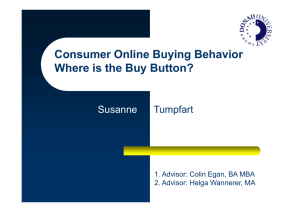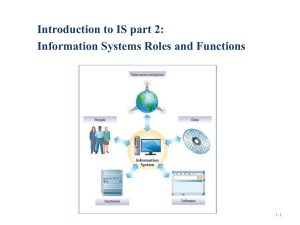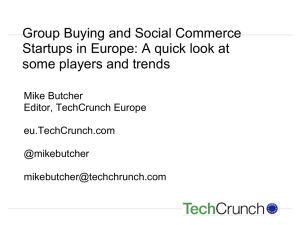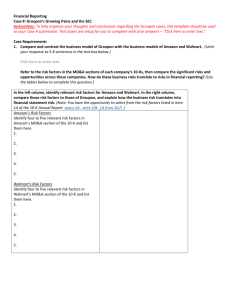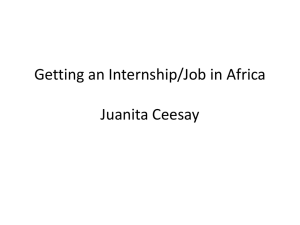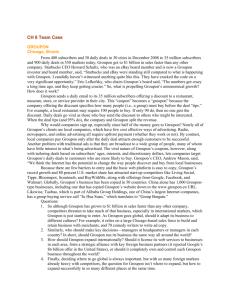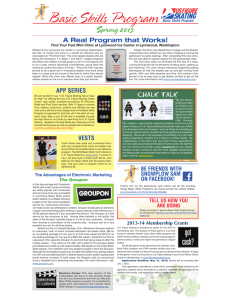Groupon, Inc - Robins School of Business
advertisement
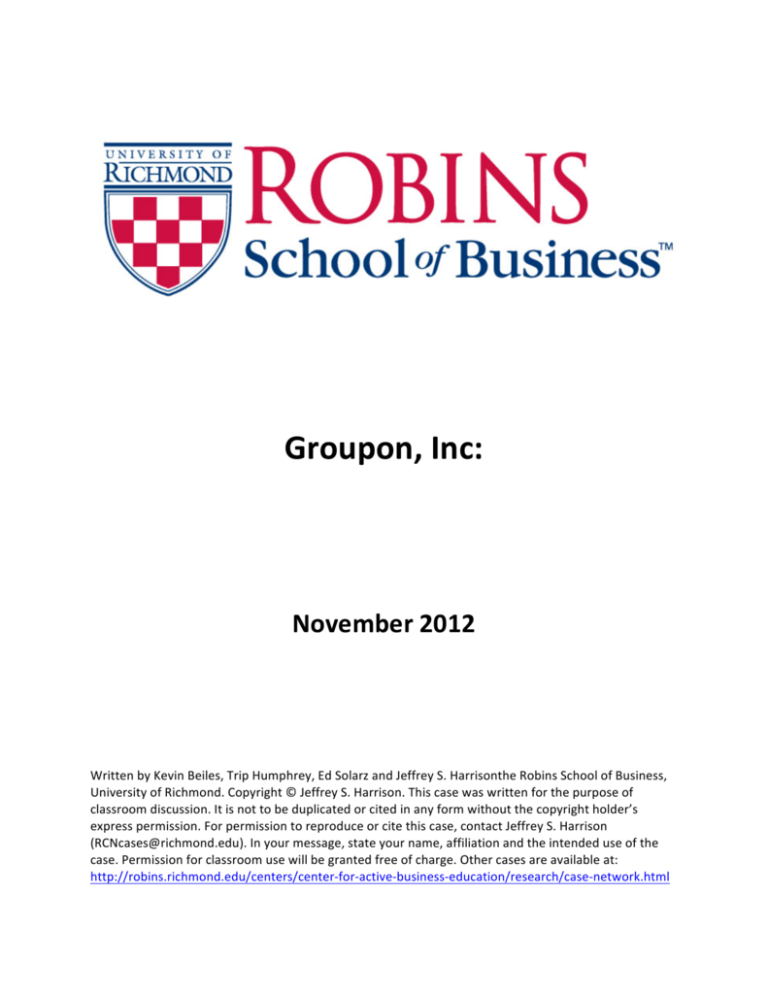
Groupon, Inc: November 2012 Written by Kevin Beiles, Trip Humphrey, Ed Solarz and Jeffrey S. Harrisonthe Robins School of Business, University of Richmond. Copyright © Jeffrey S. Harrison. This case was written for the purpose of classroom discussion. It is not to be duplicated or cited in any form without the copyright holder’s express permission. For permission to reproduce or cite this case, contact Jeffrey S. Harrison (RCNcases@richmond.edu). In your message, state your name, affiliation and the intended use of the case. Permission for classroom use will be granted free of charge. Other cases are available at: http://robins.richmond.edu/centers/center-­‐for-­‐active-­‐business-­‐education/research/case-­‐network.html In December 2010, Andrew Mason decided to reject Google’s $6 billion dollar offer to acquire Groupon – at the time the largest buyout offer in internet history1 - and instead bet on himself. After all, Mason had already been labeled on the cover of Forbes Magazine as “The Next Web Phenom,”2 and Groupon, the daily-deals website he created, was the fastest growing technology company in the world, having reached $1 billion in revenue in less time than any other company in history.3 OVERVIEW In making the offer to acquire Groupon, Google sought to dramatically expand its reach in the $133 billion U.S. local-advertising market.4 Google initially offered between $3.5 and $4 billion to purchase Groupon, but after the initial attempt failed, Google increased its offer to $6 billion. 5 Mason, with concerns about the strategic direction Groupon would take under Google ownership, spurned both offers.6 According to Mason, “Life is not about money. The reason that we made a decision to be an independent company is we quite simply wanted control of our destiny. We wanted the ability to make big bets and take smart risks and go after what we saw as a big opportunity.”7 Groupon decided to stay the course by relying on venture funding and continued in a direction that ultimately led to an initial public offering a year after the deal with Google fell apart. A month after the November, 4, 2011 IPO (NASDAQ=GRPN), it was looking as though Mason’s decision to turn down Google’s acquisition offer was paying off. Groupon’s market capitalization was just above $13 billion in December 2011, and its IPO had become the largest for a U.S.-based internet company since Google’s IPO in 2004. It appeared as though Andrew Mason was on the fast track to join such names as Jobs, Gates, and Zuckerberg as the elite in the technology industry. However, as he would soon find out, appearances can be deceiving. Since its high-water mark in November 2011, Groupon experienced a steady decline in valuation, leading to a $2.475 billion market capitalization in November 2012. Critics claimed that Groupon’s rapid decline was the result of “questionable accounting, an overvalued business model and an industry that [was] turning into the digital equivalent of junk mail.”8 Groupon’s meteoric rise and subsequent sustained fall prompted increased discussion in the newspapers, on financial talk shows, and across the investment community. During the last week of November 2012, an anonymous source informed a technology journalist that Groupon’s board was considering firing Andrew Mason.9 Mason replied to this accusation: Here's a news flash. Our stock is down about 80 percent since we IPO'd a year ago. It would be weird if the board wasn't discussing whether I'm the right guy to do the job. It's actually their chief responsibility to ask that question, as they have asked that question in the past. The only thing unusual is that it's showing up in the newspapers.”10 1 THE GROUPON STORY Groupon began as the organic extension of a young entrepreneur’s attempt to change online purchasing through a website that enabled and encouraged collective action. In January 2007, Andrew Mason tapped the resources of his former employer, Eric Lefkofsky, to create a website based on the idea of a virtual tipping point of collective action where users organized social campaigns that were only carried out once a critical mass of people joined the cause.11 In November 2007, Mason launched a website called The Point.12 The most successful campaigns undertaken on The Point involved consumers aggregating their buying power to lower purchase prices. Mason, recognizing this trend, created a blog that promoted daily deals from different vendors.13 When it became apparent that The Point lacked the ability to generate sustainable revenue, Lefkofsky encouraged Mason to pursue a strategy entirely based on this concept of daily deals combined with collective action. According to Lefkofsky, “We realized that the best way for us to monetize this technology was to show people the value of these campaigns as it relates to group purchasing.”14 Groupon was the result. Officially launched in November 2008, Groupon began as a daily deals website that offered one deal per day in each of the markets that it served. The idea caught fire and Groupon experienced record-breaking growth. Within only a year, Groupon‘s subscriber list had grown to one million members.15 After only seventeen months, Groupon was already valued at $1.35 billion.16 Over the first eighteen months after the site was launched, Groupon’s sales skyrocketed to over $500 million.17 Groupon had become the clear leader of the daily deals market. Some of the biggest names in the technology industry started to take notice of Groupon’s wild success. In late 2010, Google made a strong push to acquire the daily deals website, but its attempt was rebuffed by Mason and his team. Instead, as mentioned in the introduction, Groupon moved forward with its initial public offering. With 200 million subscribers world-wide, Groupon has the largest subscriber base in the industry. 18 Groupon has a presence in 565 markets world-wide and has the largest merchant base in the industry.19 Nevertheless, competition in the group deals market is increasing, and Groupon’s market share has begun to decline. While Groupon is still known as a daily deals website, it has begun expanding its operations to include new services and products to offer its customers and merchant partners. THE COMPANY Groupon is an online marketplace through which coupons and discounted gift-certificates for both local and national companies are offered to consumers. Colloquially known as a “dailydeals” website, Groupon offers one or more deals per day in each market it serves. The Groupon concept incorporates the idea of group coupons where a predetermined number of coupons must be sold. Utilizing this concept of a virtual tipping point, an offer becomes available to everyone once a critical mass of people signs up. However, if this critical mass is not reached, the deal is not redeemable by anyone. If a deal is redeemable, Groupon and the retailer or business where the discount is used split the proceeds at a predetermined rate. While Groupon originally offered only one deal per day in a given market, it has since developed an algorithm to offer targeted 2 deals to subscribers by location and personal preference via daily emails and its mobile application. 20 Daily deals are not the only service offered by Groupon. Pursuant to its long-term goal of creating a sustainable business model that harnesses the power of the internet to create localized e-commerce, Groupon has commenced development of new services aside from the core business of offering daily deals.21 These new services include Groupon Scheduler, Groupon Now!, Groupon Goods, Groupon Payments, Breadcrumb, and Groupon Rewards.2223 By pushing beyond daily deals with these new services, Groupon’s goal is to create an e-commerce platform that “locks in” the business of local merchants. Management Team Since its initial public offering, Groupon has experienced a revolving door of management changes. As a result, Groupon has identified two aspects of its management team that constitute risk factors that could weigh negatively on the success of the firm: (1) the management team has a limited history working together and may struggle to implement its business plan and (2) the management team is inexperienced in managing public companies.24 While these risks are present, the management team currently consists of a group of highly educated, highly motivated individuals dedicated to positioning Groupon to achieve sustainable success. In particular, founder and CEO Andrew Mason, CFO Jason Childs, and COO Kal Raman represent the notable members of the management team (see Exhibit 1).25 Founder and CEO: Andrew Mason Mason founded Groupon and has served as the CEO since the website launched in 2008. Before founding Groupon, Mason worked as a software developer for Innerworkings, Inc. While Mason has little experience running a public company, his vision and creativity helped drive Groupon’s rapid ascension. Chief Financial Officer: Jason Childs Childs joined Groupon in December 2010. Prior to joining Groupon, Childs held a number of financial senior positions with Amazon.com. In addition, Childs spent seven years with Arthur Andersen working as an accountant and consulting manager. Chief Operating Officer: Kal Raman Raman joined Groupon in May 2012 as the Senior Vice President, Americas, and was quickly promoted to Senior Vice President of Global Sales and Operations in August of 2012. By November of 2012, Raman was again promoted to his current position of Chief Operating Officer. Prior to joining Groupon, Raman worked for both Ebay and Amazon.com in executive capacities. Raman has also previously served as CEO of Global Scholar and Drugstore.com. 3 Board of Directors Pursuant to its bylaws and responsibilities as a publicly traded company, Groupon’s management team is overseen and directed by its Board of Directors (see Exhibit 2). Eric Lefkofsky serves as the Executive Chairman of the Board. Chairman Lefkofsky was the founding investor of Groupon and has previously founded or chaired a number of firms, including Innerworkings, Inc. and Echo Global Logistics, Inc. In addition to Chairman Lefkofsky, there are six other directors on the Board in addition to Andrew Mason, who sits on the Board as well. The Board of Directors is charged with ensuring that Groupon’s management team acts in accordance with ethical and regulatory guidelines as well as evaluating the strategic direction of Groupon.26 Mission Statement Groupon’s mission is “To Become the Operating System for Local Commerce”27 Pursuant to this mission, Groupon has laid out a strategic direction to achieve this goal. Strategies Because Groupon operates in an industry that is still in its infancy, Groupon’s main strategic goal has been to increase growth in order to take advantage of as many markets around the globe as possible (see Exhibit 3). Because Groupon operates under the premises of economies of networking and economies of scale, more subscribers and merchants means more revenue for Groupon. In establishing these relationships, Groupon hopes to position itself advantageously so as to further pursue its long-term goal of providing an integrated platform for local e-commerce. Pursuant to its articulated strategic direction, Groupon has outlined five distinct strategies: • • • • • Grow its subscriber and customer base Grow the number of merchant partners it features Position itself to benefit from technological changes that may affect consumer behavior Increase the number and variety of products through innovation Expand with acquisitions and business development partnerships. These strategies share a common theme of continued expansion and evolution into the future.28 So far, the key to these strategies has been acquisitions to quickly grow in size and reach new markets. Marketing Unlike traditional middlemen, Groupon does not have an operational infrastructure, production system, or physical distribution network. Instead, it acts as a purely virtual marketplace, which creates value for merchants by helping to market their products more effectively to consumers. Groupon’s growth started as an online site that largely grew through word of mouth in consumer and merchant networks. Through email and mobile applications, their subscriber base grew to 200 million, their active customer base grew to 40 million, and their merchant base grew to over 250,000.29 Groupon’s international presence grew dramatically in 2012, with nearly half of its sales outside of the US.30 Mobile use grew over 30% in the twelve months from October 2011 to 4 October 2012, and in 2012 Groupon began to use demographic targeting with a focus on demand management and increasing product diversity.31 One of the new products, Groupon Payments, is an iPhone app-based mobile payment system that offers discounts for retailers that have used Groupon in the past. It offers a 1.70% rate with a fee of $0.15 per transaction, in contrast to the industry norm of 2.75%, and also makes credit card payments available to the retailer overnight, in contrast to the industry norm of 2-3 days.32 Another product of note is Groupon Goods, a platform by which discounted products are sold directly to customers. Groupon Goods increased sales from $7.2M in the third quarter of 2011 to $145M in the third quarter of 2012.33 This stands in contrast to Groupon, Inc. missing its gross revenue target for the third quarter of 2012. According to Rolfe Winkler of Dow Jones Newswires’ Heard on the Street, The revenue shortfall came despite direct deals jumping to 26% of revenue in the third quarter, up from just 3% in the first quarter. When Groupon sells items directly, it first takes them into its own inventory. So it recognizes revenue from these deals on a gross basis. Sales of traditional spa and restaurant deals are recognized on a net basis. So as the proportion of direct deals grows, it inflates net revenue overall but undermines margins.34 In this way, the enormous growth rate of Groupon Goods has outpaced the growth rate of its core competency – the daily deal. Interestingly, Groupon Goods is essentially a product offering service, which is closer as a business model to that of online retailers like Amazon than the daily deal model. Yet, according to Andrew Mason, Groupon does not compete with the analytic capabilities of Google or the size and breadth of product offerings that Amazon offers. He explained at one point that Groupon “neither [needs] to, nor [wants] to try to, out-Amazon Amazon…We’ll never be about comprehensive product selection, but our skills at curating unbeatable offers are clearly resonating with our customers.”35 Financial Status Groupon’s finances show a lot of volatility.36 Revenue grew dramatically in 2010, from $15M in the second quarter to $573M by the fourth quarter. Interestingly, it fell nearly as far by the second quarter of 2011 to $43M. Net losses turned positive for the first time in the second quarter of 2012 with $28M in earnings, but the company just reported a $3M loss in the third quarter of 2012 (see exhibit 4). Since its IPO on November 4, 2011, to its all-time low on November 13, 2012, Groupon’s stock had declined 88.93%. Articles were written in jest about the Groupon daily deal model, with one from the Wall Street Journal taunting, “Get your Daily-Deal Stocks – 75% Off!”37 5 THE INDUSTRY Groupon was a pioneer in creating a platform to connect merchants and consumers through online discounts. As the market noticed Groupon’s success, an industry formed focusing on “daily deals,” which by November 2012 included many competitors.38 While the industry quickly became saturated, Groupon continued to experience growth in subscribers, with growth accelerating in two years from six hundred thousand to over one hundred and forty million. Companies offering daily deals essentially interact with two clients: the businesses that offer the deals, and the customers that buy and engage in these deals. Groupon’s story is also an indirect product of economic factors beyond the realm of social ecommerce. Because macroeconomic conditions worsened significantly in 2008 (and for years thereafter) following the collapse of Lehman Brothers and the rapid decline in United States home prices, daily deals promotions became an increasingly attractive way for businesses to add value to their offerings and continue to reach customers. While it is not clear that Groupon and its competitors owe their existence to a poor economic climate, it is clear that these conditions helped enable Groupon’s strategy to become successful when many other business models were beginning to fail or had already failed. No empirical relationship has been identified between consumer confidence and the stock price of Groupon, but relationships between unemployment rates as well as per capita income levels show a direct and positive relationship with the growth of daily deal businesses.39 The growth of social networks has also served as a catalyst for the growth of the daily deal business. In many cases, deals are aggregated via groups of subscribers and then promoted via standard social networks such as Facebook, Twitter, or Google+. In this way, the operational vision of these daily deal networks is linked to the maturity of the social network industry. Even more recently, mobile technology has begun to engage users with advertisements that fit their consumption of the services being provided, and participants in the social deal-a-day marketplace have begun to integrate the use of mobile technology into their visions. CEO Mason, in an investor’s meeting, spoke of the importance of their mobile presence with their new Groupon Now application. The goal of this application is to allow users to focus on expanding their local deal consumption based on mobile location information being provided via the smartphone infrastructure. Not surprisingly, competitors of Groupon are also strengthening their mobile offerings. The mobile component of the services these companies are providing will continue to grow, and, it has been argued, mobile may be the only true way their relevance will be maintained.40 Competition Imitability is, arguably, the Achilles’ heel of the daily deal industry. While Groupon currently enjoys a strong foothold as the number one offering for this service, it is followed by some fairly large competitors, including LivingSocial, TravelZoo, Google Offers, and Amazon Local.41 In addition to the big players, Yipit, a social deal data aggregation service, claims a database of 831 deal offerings similar to Groupon.42 The overwhelming majority of these are very small regional competitors and as such do not possess the volume that Groupon does. The ease with which companies can recreate the same essential product offering in and of itself is problematic, but the 6 size and success rate of these companies affords Groupon the ability to expand through acquisition. Groupon leadership explained that the most difficult part of expanding its offerings is maintaining the relationships with the merchants Groupon requires to offer deals to web subscribers. By purchasing its competition it is able to leverage the relationships the local competitors had already established and then keep on the owners as management for that new region and continue what they were doing previously, only with the backing of Groupon on their side.43 On the other hand, data aggregation sites, such as Yipit, focus on allowing consumers to compare deals being provided by competitors in this market. The availability of this information allows the market to function more efficiently and forces margins for daily deal providers to shrink over time. Additionally, credit card companies will begin offering the tools directly to merchants to allow them to participate in similar promotions while cutting out the daily deal “middleman.”44 For all of these reasons, Groupon’s foothold within the industry is uncertain. LivingSocial LivingSocial was founded in 2007 and is Groupon’s primary competitor. LivingSocial has had a more tight-knit experience with the social component of sharing and distributing deals through preexisting social networks, both digital and human. Similar to Groupon, merchants work with LivingSocial to construct deals to be offered via one of LivingSocial’s distribution methods. A portion of the sales collected through LivingSocial are returned to the merchant as revenue to offset the credit extended via the coupon deal. Though it ranks second in the industry, the gap between Groupon and LivingSocial is wide and potentially widening. Recent numbers put LivingSocial at roughly 60 million subscribers to their web, email, mobile app, and social network deal distribution methods.45 This is less than half of the volume of Groupon.46 LivingSocial’s total revenue in 2011 was $245 million with a net loss of over $500 million. Compared to Groupon, with $1.6 billion in revenue and a net loss of $275 million, it is evident that LivingSocial is struggling to keep up.47 That being said, the company is continuing to stay relevant as it continues to expand through acquisitions, which are focusing on expanding offerings into new regions as well as technological investments into companies that will provide better interfacing with service-based point-of-sale systems. Additionally, LivingSocial retains backing from Amazon (despite offering competing services). Google and Amazon Other than LivingSocial, the biggest competitive challenges facing Groupon are Google and Amazon. Google has its own offering already, in the form of Google Offers. While the service has not experienced the rocket-like growth that both LivingSocial and Groupon experienced near their inception, Google and Amazon are the largest companies on the internet with experience matching consumers to the information or products they want or need. Google excels at providing information through its internet search service. For this reason, Google has a considerable advantage in providing daily deals because it can deliver a particular type of deal to a particular type of customer, instantaneously and simultaneously, for millions of different types 7 of requests.48 Additionally, Google provides a number of services beyond search, such as Google Offers. This platform has a location-based focus that relies heavily on Google’s data collection methods, and becomes more robust as a consumer uses more services from Google. A large chunk of this data collection in the United States comes from consumers’ smartphones, and Google’s Android operating system is continuing to grow the smartphone market. Amazon is the world’s largest online marketplace. Amazon survived the internet bubble, and continues to grow and expand its myriad offerings of goods. While Amazon does not have the search heuristics that Google provides, it has a large client base that it is offering its AmazonLocal product. LOOKING FORWARD Groupon experienced enormous growth as a trendsetter in the daily deals market, and maintains its lead globally in the industry today. Concerns about the sustainability of the industry itself seem to overshadow concerns about the performance of the company within the industry. While Groupon is moving ahead with a number of strategic initiatives, and is demonstrating growth in a number of capacities, its latest earnings announcement showed a loss of $3 million, which only reinforced analysts’ and investors’ concerns about the fate of the company. Groupon is in a precarious situation. However, management remains optimistic that the company has plenty of opportunities for growth. In November 2012, Groupon attempted to assuage investors after its poor quarterly earnings announcement by releasing a PowerPoint slide deck on its website, making the following points: • Local commerce is a “$3 Trillion market,” with Groupon making up only 0.2%. • There are approximately 28.8 billion monthly internet searches for local merchants, while monthly searches for local deals are still “too small to measure.” • The ratio of Groupon’s revenue to search traffic for local deals remains significantly lower than the ratio of revenue to search traffic of the internet “travel leader,” “e-commerce leader,” and “content leader” within their respective markets. • Groupon has $1.2B in cash and cash equivalents, with no LTD. • “Active deal count” has increased in North America by over 1000% yearover-year. • The international market remains in the “early stages” of technology, tools, and processes. • Customer satisfaction scores (CSAT) have improved worldwide throughout 2012. • Groupon sales reps have closed contracts at an increasing rate from July through October 2012.49 What should Groupon’s Board of Directors do? Should they keep Andrew Mason on? Can Groupon make a comeback following its decline in value since its IPO? What kind of strategic plan should the Board pursue going forward? And, looking back, what could Groupon have done differently? 8 EXHIBIT 1: MANAGEMENT TEAM Andrew Mason, Chief Executive Officer Andrew is the founder of Groupon and has served as our Chief Executive Officer since our inception in November 2008. Prior to co-founding Groupon and The Point, Andrew worked as a software developer with Innerworkings, Inc. Andrew received his Bachelor of Arts in Music from Northwestern University. Jason Child, Chief Financial Officer Jason joined Groupon as Chief Financial Officer in December 2010. Before Groupon, Jason held a number of senior positions at Amazon.com including CFO and VP of Finance, International. Prior to joining Amason.com, Mr. Child spent more than seven years as a C.P.A. and a consulting manager at Arthur Andersen. He has lived and worked in Munich, Tokyo, and Seattle. He received his Bachelor of Arts from the Foster School of Business at the University of Washington. Kal Raman, Chief Operating Officer Kal joined the Company in May 2012 as our SVP, Americas, and was appointed as SVP, Global Sales and Operations in August 2012. Prior to joining Groupon, Kal worked for Ebay as VP Global Fulfillment, and served as CEO of Global Scholar. Earlier in his career, he also served as CEO of Drugstore.com and as an executive at Amazon.com, Inc. Jason Harinstein, Senior Vice President of Corporate Development Jason has been Groupon’s Senior Vice President of Corporate Development since March 2011. Before coming to Groupon, Jason worked in Corporate Development at Google, where he led the DoubleClick acquisition. Jason received his Bachelor of Arts in Economics at Northwestern University and his MBA from the Booth School of Business at the University of Chicago. Jeff Holden, Senior Vice President of Product Management Jeff has been Senior Vice President of Product Management since April 2011 and is driven by a highly-caffeinated desire to discover new ways for people to have great experiences using Groupon. Prior to joining Groupon, Jeff was the CEO and co-founder of Pelago, whose flagship product, Whrrl, was designed to help people get out of a social rut and discover new things in their cities. Jeff also spent more than eight years at Amazon.com, where he was Senior Vice President of Consumer Websites, Worldwide. Jeff received both his bachelor’s and master’s degrees in computer science from the University of Illinois at Urbana-Champaign. David Schellhase, General Counsel David has been Groupon’s General Counsel since June 2011. Prior to Groupon, David worked at Salesforce.com as the EVP of Legal. David received his Bachelor of Arts from Columbia University and his JD from Cornell Law School. 9 Brian Schipper, Senior Vice President of Human Resources Skip has been Groupon’s Head of Global Human Resources since June 2011. Skip has worked for a variety of companies including Microsoft, Cisco, and PepsiCo. He received his Bachelor of Arts in Business and English from Hope College and his MBA from the Eli Broad Graduate School of Management at Michigan State University. Brian Totty. Senior Vice President of Engineering & Operations Brian has served as our Senior Vice President of Engineering since November 2010. He came to Groupon from Ludic Labs, a startup venture developing a new class of software, where he was CEO. While at Ludic Labs, Brian created the Diddit social platform and the Offer Foundry selfservice deal exchange. Groupon acquired Ludic Labs in November 2010. Before that, Brian was co-founder and Senior Vice President of Research and Development of Inktomi Corporation and helped lead Inktomi to become the biggest IPO of 1998. He received his Ph.D. in computer science from the University of Illinois at Urbana-Champaign, his Masters of Public Administration from Harvard’s Kennedy School and his Bachelor of Science from Massachusetts Institute of Technology. Source: Groupon, Inc. 2012. Management, http://investor.groupon.com/management.cfm. Accessed November 27, 2012. 10 EXHIBIT 2: BOARD OF DIRECTORS Eric Lefkofsky, Executive Chairman Eric Lefkofsky is the co-founder of and Executive Chairman of Groupon. He is also a founder and director of several firms, including InnerWorkings, Inc. (NASDAQ: INWK), a global provider of managed print and promotional solutions; Echo Global Logistics, Inc. (NASDAQ: ECHO), a technology-enabled transportation and logistics outsourcing firm; MediaBank, LLC, a leading provider of integrated media procurement technology; and LightBank, a venture fund focused on helping disruptive technology businesses. Eric serves on the board of directors of Children’s Memorial Hospital and the board of trustees of the Steppenwolf Theatre, the Art Institute of Chicago, and the Museum of Contemporary Art. Eric is also an adjunct professor at the University Of Chicago Booth School of Business. He holds a bachelor’s degree from the University of Michigan and a Juris Doctor degree from the University of Michigan Law School. Peter Barris, Director Peter joined New Enterprise Associates (NEA) in 1992 and has served as Managing General Partner since 1999. Since joining NEA, Peter has led investments in over 20 information technology companies that have completed public offerings or successful mergers. These include such industry pioneering companies as Amisys, CareerBuilder, InnerWorkings, Neutral Tandem, UUNET, and Vonage. Prior to joining NEA, Peter was President and Chief Operating Officer of Legent Corporation (LGNT) and Senior Vice President of the Systems Software Division of UCCEL Corporation (UCE). Both companies were ultimately acquired at valuations that were record breaking at their time. Earlier, Peter spent almost a decade at General Electric Company in a variety of management positions, including Vice President and General Manager at GE Information Services. Outside interests include serving on the Northwestern University Board of Trustees, the Dartmouth Tuck School Board of Overseers. Peter previously served on the Executive Committee of the Board of the National Venture Capital Association and was also a founding member of Venture Philanthropy Partners, a philanthropic organization in the Washington, D.C. area. He has a BS degree in Electrical Engineering from Northwestern and an MBA from Dartmouth. Robert Bass, Director Robert Bass served as a vice chairman of Deloitte LLP from 2006 through June 2012, and was a partner in Deloitte from 1982 through June 2012. Mr. Bass specializes in e-commerce, mergers and acquisitions and SEC filings. At Deloitte, Mr. Bass was responsible for all services provided to Forstmann Little and its portfolio companies and is the advisory partner for Blackstone, DIRECTV, McKesson, IMG and CSC. He has also previously been the advisory partner for priceline.com, RR Donnelley, Automatic Data Processing, Community Health Systems and Avis Budget. He is a member of the American Institute of Certified Public Accountants and the New York and Connecticut State Societies of Certified Public Accountants. 11 Daniel Henry, Director Daniel has been the Chief Financial Officer of American Express Company since October 2007. Henry is responsible for leading American Express Company’s finance organization and representing American Express to investors, lenders and rating agencies. He has also served as Executive Vice President and Chief Financial Officer of U.S. Consumer, Small Business and Merchant Services and joined American Express as Comptroller in 1990. Prior to joining American Express, Henry was a partner with Ernst & Young. Mellody Hobson, Director Mellody Hobson is president of Ariel Investments, a Chicago-based money management firm serving institutional clients and individual investors; she also serves as chairman of the board of trustees for Ariel’s no-load mutual funds. Beyond her work at Ariel, Mellody has become a nationally recognized voice on financial literacy and investor education. Specifically, she is a regular financial contributor on Good Morning America, the featured consumer finance expert on Tom Joyner’s Money Mondays radio program and a regular columnist for Black Enterprise. Mellody is a director of three public companies: DreamWorks Animation SKG, Inc., The Estee Lauder Companies Inc. and Starbucks Corporation. In addition, she serves on the boards of various civic organizations including The Field Museum, The Chicago Public Education Fund and the Sundance Institute. Mellody is a graduate of Princeton University where she received her AB degree from the Woodrow Wilson School of Public and International Affairs. Brad Keywell, Director Brad is a founder of MediaBank LLC, Echo Global Logistics, Inc., Groupon Inc., Starbelly, and several other companies. He is on the Board of Zell-Lurie Entrepreneurship Institute at the University of Michigan, Big Communications, Warrior Productions, and University of Michigan Hillel Foundation. He was formerly on the Board of Columbia College, as well as the Advisory Committee of the University of Chicago Graduate School of Business Directors’ College. Ted Leonsis, Director Ted is vice chairman emeritus of AOL LLC with more than a decade of experience in global Internet services and media at AOL, where he also served as vice chairman and president of several business units. In addition to his work at AOL, Leonsis in the majority owner of the National Hockey League’s Washington Capitals and the Women’s National Basketball Association’s Washington Mystics. He is also the producer of “Nanking,” a documentary film that made its premiere at the 2007 Sundance Film Festival. Source: Groupon, Inc, 2012. Board of directors. http://investor.groupon.com/directors.cfm. Accessed November 27, 2012. 12 EXHIBIT 3: STRATEGY Our objective is to become an essential part of everyday local commerce for consumers and merchants. Key elements of our strategy include the following: Grow our subscriber and customer base. We have made significant investments to acquire subscribers through online marketing initiatives, such as search engine marketing, display advertisements, referral programs and affiliate marketing. In addition, our subscriber base has increased by word-of-mouth. We intend to continue to invest in acquiring subscribers so long as we believe the economics of our business support such investments, however we have continued to shift our efforts towards converting subscribers into customers who purchase Groupons. We do so by providing more targeted and real-time deals, delivering high quality customer service and expanding the number and category of deals we offer. We intend to continue investing in the development of increased relevance of our service as the number and variety of the deals we offer our subscribers increase and we gain more information about our subscribers’ interests. Our investment in the growth of our subscriber base and achieving optimal subscriber levels at any given time will be directly linked to the breadth and location of our base of merchant partners. As such, while total subscribers is a key metric to measure our progression over the long term, it is not a key operational metric in the same manner as is our active customer base, which we discuss below. Grow the number of merchant partners we feature. To drive merchant partner growth, we have expanded the number of ways in which consumers can discover deals through our marketplace. We adjust the number and variety of products we offer merchant partners based on merchant demand in each market. We have also made significant investments in our sales force, which builds merchant partner relationships and local expertise. Our merchant partner retention efforts are focused on providing merchant partners with a positive experience by offering targeted placement of their deals to our subscriber base, high quality customer service and tools to manage deals more effectively. For example, we offer an array of tools for merchant partners, as described under “-Our Merchant Partners” below. We routinely solicit feedback from our merchant partners to ensure their objectives are met and they are satisfied with our services. Based on this feedback, we believe our merchant partners consider the profitability of the immediate deal, potential revenue generated by repeat customers and increased brand awareness for the merchant partners and the resulting revenue stream that brand awareness may generate over time. Some merchant partners view our deals as a marketing expense and may be willing to offer deals with little or no immediate profitability in an effort to gain future customers and increased brand awareness. As our suite of services for merchant partners continues to expand, we are constantly iterating our emphasis on either growing the merchant partner base or deepening our relationship with our existing merchant partner base, informed by a number of variables including category, customer and other market-specific conditions. Position ourselves to benefit from technological changes that may affect consumer behavior. We believe that, as technological advances continue, particularly with the proliferation of affordable smartphones and tablet computers, the ways in which customers and local merchant partners interact will change significantly. For example, in December 2011, one quarter of all purchases in our North America segment were made through mobile devices. While we cannot predict all 13 of the ways in which these changes will affect consumer behavior in the local marketplace, we believe that we are well positioned to benefit from, and to drive, these changes. We continue to invest heavily in technology, including through acquisitions. Increase the number and variety of our products through innovation. We have launched a variety of new products in the past 12 months and we plan to continue to launch new products to increase the number of customers and merchant partners that transact business through our marketplace. For example, we launched Groupon Now!, real-time deals that consumers can use in the moment when they’re hungry or bored. Groupon Now! enables merchant partners to manage the flow of customers into their business at specific times, such as when their business is slow. In 2011, we also launched Groupon Goods, which enables consumers to purchase vouchers for products directly from our website, Groupon Getaways, through which we offer deals on travel, and GrouponLive, through which we offer deals on concert tickets and other live events. As our local commerce marketplace grows, we believe consumers will use Groupon not only as a discovery tool for local merchant partners, but also as an ongoing connection point to their favorite merchants. Expand with acquisitions and business development partnerships. Historically, the core assets we gained from acquisitions were local management teams and small subscriber and merchant partner bases, to which we then apply our expertise, resource and brand to scale the business. More recently, our focus has shifted to acquiring businesses with technology and technology talent that can help us expand our business. In addition to acquisitions, we have entered into agreements with local partners to expand our international presence. For example, in February 2011, we entered into a partnership with TCH Burgundy Limited, or Tencent, a Chinese Internet company, to operate a Chinese e-commerce website. In addition, in March 2012 we announced a partnership with Deutsche Telekom, pursuant to which our mobile application will be distributed as a standard feature with their smartphone devices throughout Europe. We have also entered into affiliate programs with companies such as eBay, Microsoft, Yahoo and Zynga, pursuant to which these partners display, promote and distribute our deals to their users in exchange for a share of the revenue generated from our deals. We intend to continue to expand our business with acquisitions and business development partnerships. Source: Groupon, Inc. 2011. Groupon, Inc.: 2011 annual report. Chicago, IL: Groupon, Inc. 14 EXHIBIT 4: GROUPON REVENUE VS. NET INCOME PER QUARTER GRPN Revenue vs Net Income Per Quarter 800 600 ($Millions) 400 200 0 2Q10 3Q10 4Q10 1Q11 2Q11 3Q11 4Q11 1Q12 -­‐200 -­‐400 -­‐600 Revenue Net Income (Loss) 15 2Q12 3Q12 REFERENCES 1 2012. Behind Groupon’s $6 billion brushoff. Wall Street Journal (Online). June 5. http://online.wsj.com/article/SB10001424052702303640104577440580610986086.html. Accessed November 29, 2012. 2 Weiss, B. 2010. Groupon’s $6 billion gambler. Wall Street Journal, December 18: A15. 3 Weiss, B. 2010. Groupon’s $6 billion gambler. Wall Street Journal, December 18: A15. 4 MacMillan, D., & Galante, J. 2010. Google’s Groupon bid said rejected. BusinessWeek.com. December 6. http://search.ebscohost.com/login.aspx?direct=true&db=bth&AN=55713957&site=bsi-live. Accessed November 16, 2012. 5 MacMillan, D. 2010. Google said to near deal to buy Groupon for $6 billion. Bloomberg.com. November 30. http://www.bloomberg.com/news/2010-11-30/google-said-to-near-agreement-to-buy-groupon-for-6-billion.html. Accessed November 23, 2012. 6 MacMillan, D., & Galante, J. 2010. Google’s Groupon bid said rejected. BusinessWeek.com. December 6. http://search.ebscohost.com/login.aspx?direct=true&db=bth&AN=55713957&site=bsi-live. Accessed November 16, 2012. 7 Etter, L., & MacMillan, D. 2012. The education of Groupon CEO Andrew Mason. Bloomberg Businessweek. July 12: 48-53. 8 Conlin, M. 2011. Groupon’s fall to earth swifter than its fast rise. Charleston Gazette, October 22: 6A. 9 Harris, M. Melissa Harris’ Chicago confidential. The Chicago Tribune (Online). http://www.chicagotribune.com/business/ct-biz-1129-confidential-mason-20121130,0,7445810.column. Accessed November 29, 2012. 10 Ibid. 11 Weiss, B. 2010. Groupon’s $6 billion gambler. Wall Street Journal, December 18: A15. 12 Groupon, Inc., 2012. About Groupon. http://www.groupon.com/about. Accessed November 27, 2012. 13 Steiner, C. 2010. Meet the fastest growing company ever. Forbes Magazine (online). August 30. http://www.forbes.com/forbes/2010/0830/entrepreneurs-groupon-facebook-twitter-next-web-phenom.html. Accessed November 20, 2012. 14 Cohen, D. 2009. Virtual “tipping point” leverages group deals. Reuters.com. June 10. http://www.reuters.com/assets/print?aid=USTRE5592K720090610. Accessed November 24, 2012. 15 Hughes, S., & Beukes, C. 2012. Growth and implications of social e-commerce and group buying daily deal sites: the case of Groupon and Livingsocial. International Business & Economics Research Journal, 11(8): 921934. 16 Steiner, C. 2010. Meet the fastest growing company ever. Forbes Magazine (online). August 30. http://www.forbes.com/forbes/2010/0830/entrepreneurs-groupon-facebook-twitter-next-web-phenom.html. Accessed November 20, 2012. 17 Hughes, S., & Beukes, C. 2012. Growth and implications of social e-commerce and group buying daily deal sites: the case of Groupon and Livingsocial. International Business & Economics Research Journal, 11(8): 921934. 18 IBISWorld (2012, February). Industry Report OD5452: Daily Deal Sites in the US, pp. 21. 19 Hughes, S., & Beukes, C. 2012. Growth and implications of social e-commerce and group buying daily deal sites: the case of Groupon and Livingsocial. International Business & Economics Research Journal, 11(8): 921934. 20 IBISWorld (2012, February). Industry Report OD5452: Daily Deal Sites in the US, pp. 21. 21 Groupon, Inc. 2011. Groupon: 2011 Letter to Stockholders. Chicago, IL: Groupon, Inc. 22 Etter, L., & MacMillan, D. 2012. The education of Groupon CEO Andrew Mason. Bloomberg Businessweek. July 12: 48-53. 23 Rusli, E., & Letzing, J. 2012. Groupon’s growth slows; shares plummet after-hours; daily deals sites report narrower loss; investors dump stock after-hours. Wall Street Journal (Online). November 9. http://online.wsj.com/article/SB10001424127887323894704578107304122978748.html. Accessed November 24, 2012. 24 Groupon, Inc., 2011. Form 10-K. Chicago, IL: Groupon, Inc.: 30. 25 Groupon, Inc., 2012. Management, http://investor.groupon.com/management.cfm. November 27. 26 Groupon, Inc., 2012. Board of directors, http://investor.groupon.com/directors.cfm. November 27. 16 27 Groupon, Inc. 2011. Groupon: 2011 Letter to Stockholders. Chicago, IL: Groupon, Inc. Groupon, Inc., 2011. Form 10-K. Chicago, IL: Groupon, Inc.: 7. 29 Groupon, Inc. 2012. Investor deck, November 2012. http://files.shareholder.com/downloads/AMDAE2NTR/2192449792x0x577460/A1ADF349-1D35-4ECC-AF5A585EBE66C865/November_2012_Investor_Presentation.pdf. Accessed November 15, 2012. 30 Rusli, E. and Letzing, J. 2012. Corporate News: Groupon Comes Up Short – Daily Deals Site Reports Slowing Growth; Investors Dump Stock After-Hours. Wall Street Journal. November 9: J-B2. 31 Ibid. 32 MarketWatch: Financial Services. 2012. Groupon enters the POS market, with questions regarding the longterm sustainability of the move. 12(11):11. 33 Rusli, E. and Letzing, J. 2012. Corporate news: Groupon comes up short – daily deals site reports slowing growth; investors dump stock after-hours. Wall Street Journal. November 9: J-B2. 34 Winkler, R. 2012. Groupon’s wall of worry. Wall Street Journal – Eastern Edition. Volume 260, Issue 112: C10. 35 Shalvey, K. 2012. Groupon stock dealt new low after Q3 results. Investor’s Business Daily (Online). November 09, 2012. http://news.investors.com/technology/110912-632858-groupon-stock-tumbles-on-weakq3.htm?fromcampaign=1. Accessed November 26, 2012. 36 The information in this paragraph is from Groupon, Inc., 2011. Form 10-K. Chicago, Illinois: Groupon, Inc.: 65; Groupon, Inc., 2012. Forms 10-Q. Chicago, Illinois: Groupon, Inc.: 4; Morningstar, Investment Research Center, http://newman.richmond.edu:2693/Stock/balance-sheet?country=USA&t=GRPN. Accessed November 15, 2012. However, we did not include the actual financial statements because they are practically impossible to interpret. 37 Kessler, A. 2012. Get your daily-deal stocks – 75% off! Wall Street Journal. Volume 260, Issue 103: A15. 38 Culbert, K. 2012. IBISWORLD Industry Report OF5452 Daily Deals in the US. Retrieved November 2012 from IBISWorld Database. 6. 39 Ibid. 40 Culbert, K. 2012. IBISWORLD Industry Report OF5452 Daily Deals in the US. Retrieved November 2012 from IBISWorld Database. 8. 41 Ibid. 42 2012. Raw Daily Deal Data. Yipit. http://yipit.com/data/raw/, Accessed November 15, 2012. 43 Hughes, S., & Beukes, C. 2012. Growth And Implications Of Social E-Commerce And Group Buying Daily Deal Sites: The Case Of Groupon And Livingsocial. International Business & Economics Research Journal, 11(8), 921-934. 926. 44 BofA Launches Web Portal For Merchant Deals. 2012. ISO & Agent, 8(30), 17. 45 Hughes, S., & Beukes, C. 2012. Growth And Implications Of Social E-Commerce And Group Buying Daily Deal Sites: The Case Of Groupon And Livingsocial. International Business & Economics Research Journal, 11(8), 921-934. 924. 46 Ibid. 47 Winkler, R. 2012. LivingSocial May Need a Deal of Its Own. The Wall Street Journal, November 1: C10. 48 Culbert, K. 2012. IBISWORLD Industry Report OF5452 Daily Deals in the US. Retrieved November 2012 from IBISWorld Database. 17. 49 Groupon, Inc. 2012. Investor deck, November 2012. http://files.shareholder.com/downloads/AMDAE2NTR/2192449792x0x577460/A1ADF349-1D35-4ECC-AF5A585EBE66C865/November_2012_Investor_Presentation.pdf. Accessed November 15, 2012. 28 17
